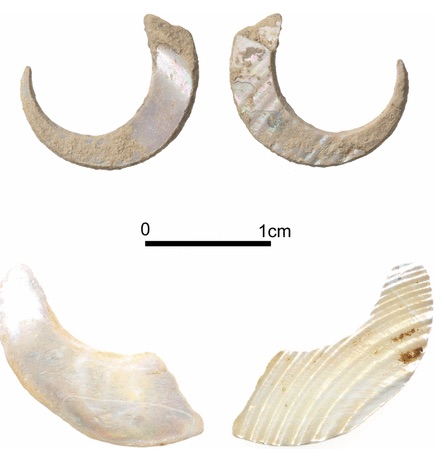23,000-year-old fishing hooks found in Sakitari Cave in Okinawa

Recently on the coast of Okinawa, Japan, in the Sakitari cave, researchers and archeologists have discovered the world’s oldest fishing hooks which have been dated at nearly 23,000 years old.
These hooks have been crafted from Sea Snail shells and they’ve also found some other tools such as scrapers made from bivalves and shell beads.
Well-preserved fishhook pieces, one finished and another unfinished.
These were single-piece hooks manufactured by splitting and grinding the flat bottom parts of Trochus shells. An allochthonous sandstone piece shows a smoothed surface that may have been used for the grinding process. Another broken shell fragment of the flat bottom part of Trochus may have been a blank for fishhook production.

The finished fishhook from Sakitari Cave was found in situ, according to the Science Mag.
The Sakitari seashell artifacts include the world’s oldest fishhook, found in situ from a layer dated to 23,000 cal BP. These single-piece fishhooks, made of Trochus shells, are comparable or older in age than the similar fishhooks reported from Timor (∼23,000−16,000 cal BP) and New Ireland (c. 18,000−20,000 14C BP).
The new Sakitari Cave evidence demonstrates that fishhook technology was widely distributed from Wallacea northward to the western Pacific margin by LGM times.
The Sakitari cave is situated on the island of Okinawa and has controversially had US armed forces there since the end of World War 11, it’s been as a key strategic staging post for the region. the island has a long history with many artefacts being found in the past such as shell axes from 2500 years ago.
The island is also famous for having one of the longest living populations on earth.

It was thought that the islands would have been a harsh place to live with few resources but this find is changing that thinking, catching food is often reliant on the tools at hand, but as we discover more tools such as these fishing hooks we get a better picture of what they’re capable of doing and we’re forced to reevaluate because they’re more resourceful than we thought over a wider ranging area.
“Our findings suggest that Paleolithic people had adapted their maritime technologies to live not only in Wallacea and Australia, but a much wider geographic zone,” Fujita told CNN.
If you have any comments then please drop us a message on our Outdoor Revival Facebook page
If you have a good story to tell or blog let us know about it on our FB page, we’re also happy for article or review submissions, we’d love to hear from you.
We live in a beautiful world, get out there and enjoy it.
Outdoor Revival – Reconnecting us all with the Outdoors
